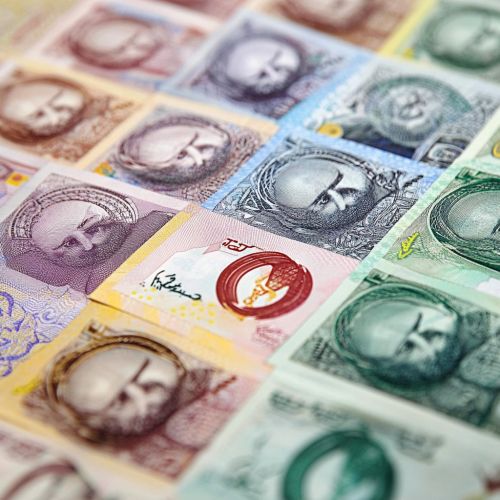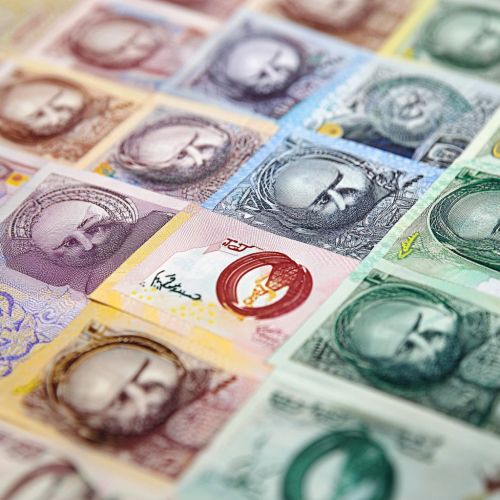Iranian rial
Iranian Rial
The Iranian rial (IRR) is the official currency of Iran. It is subdivided into 100 dinars, although dinar denominations are no longer used in everyday transactions. The currency is issued by the Central Bank of the Islamic Republic of Iran (CBI). The rial has faced significant devaluation over the years due to various economic factors, including international sanctions and domestic economic policies.


History
The rial was first introduced in 1798 as a coin worth 1,250 dinars or one-eighth of a toman. It replaced the qiran at par in 1932, and the toman was subsequently redefined as 10 rials. The rial has undergone several redenominations and revaluations throughout its history, reflecting the country's economic conditions.
Early History
The initial introduction of the rial was part of a broader monetary reform aimed at stabilizing the Iranian economy. The early rial coins were made of silver and were widely accepted in trade. However, the value of the rial fluctuated significantly due to political instability and economic challenges.
Modern Era
In the modern era, particularly after the 1979 Islamic Revolution, the rial faced severe inflationary pressures. The Iran-Iraq War (1980-1988) further exacerbated the situation, leading to a rapid devaluation of the currency. In response, the government introduced various measures to stabilize the currency, including pegging it to the U.S. dollar and implementing strict foreign exchange controls.
Monetary Policy
The Central Bank of the Islamic Republic of Iran is responsible for formulating and implementing the country's monetary policy. The CBI aims to control inflation, stabilize the currency, and promote economic growth. However, the effectiveness of these policies has been limited by external factors such as international sanctions and internal challenges like economic mismanagement.
Exchange Rate Regime
Iran has experimented with various exchange rate regimes over the years. Currently, the country operates a multiple exchange rate system, which includes an official rate set by the CBI, a market rate, and a subsidized rate for essential goods and services. This complex system aims to balance the need for economic stability with the realities of international trade and sanctions.
Inflation and Devaluation
Inflation has been a persistent issue for the Iranian economy. High inflation rates have eroded the purchasing power of the rial, leading to frequent devaluations. The government has periodically redenominated the currency to simplify transactions and restore confidence. For instance, in 2020, the Iranian parliament approved a plan to replace the rial with the toman, at a rate of 10,000 rials to one toman, although this change has yet to be fully implemented.
Banknotes and Coins
The Iranian rial is issued in both banknotes and coins. The design and denominations of these currency forms have evolved over time to reflect changes in the economy and political landscape.
Banknotes
Iranian rial banknotes are issued in various denominations, ranging from 1,000 to 1,000,000 rials. The designs often feature prominent historical and cultural figures, as well as significant landmarks. The security features of the banknotes include watermarks, security threads, and holographic strips to prevent counterfeiting.
Coins
Coins are issued in denominations ranging from 50 to 5,000 rials. They are made from various metals, including aluminum, copper, and nickel. The designs typically feature national symbols and important historical figures.
Economic Impact
The value of the Iranian rial has a significant impact on the country's economy. A weak rial makes imports more expensive, contributing to inflation. Conversely, it can make Iranian exports more competitive on the international market. The fluctuating value of the rial also affects foreign investment and the overall economic stability of the country.
International Trade
Iran's international trade is heavily influenced by the value of its currency. Sanctions have restricted Iran's ability to engage in global trade, leading to a reliance on barter systems and alternative currencies. The rial's devaluation has made it challenging for Iranian businesses to import goods and services, further straining the economy.
Domestic Economy
Domestically, the devaluation of the rial has led to increased costs for everyday goods and services. This has placed a significant burden on the Iranian population, particularly those with fixed incomes. The government has attempted to mitigate these effects through subsidies and social welfare programs, but these measures have had limited success.
Future Prospects
The future of the Iranian rial is uncertain, given the ongoing economic challenges and geopolitical tensions. The proposed redenomination to the toman is expected to simplify transactions and restore some confidence in the currency. However, the long-term stability of the rial will depend on broader economic reforms and the resolution of international sanctions.
Redenomination
The redenomination plan involves replacing the rial with the toman, at a rate of 10,000 rials to one toman. This change aims to simplify financial transactions and reduce the psychological impact of dealing with large numbers. The success of this plan will depend on the government's ability to control inflation and stabilize the economy.
Economic Reforms
Broader economic reforms are essential for the long-term stability of the Iranian rial. These reforms include improving fiscal discipline, enhancing the business environment, and attracting foreign investment. The government has announced various initiatives to address these issues, but their implementation has been slow and inconsistent.
Geopolitical Factors
Geopolitical factors, particularly international sanctions, play a crucial role in the future of the Iranian rial. The lifting of sanctions could provide a significant boost to the economy, allowing for greater integration into the global market. Conversely, the imposition of additional sanctions could further weaken the rial and exacerbate economic challenges.
